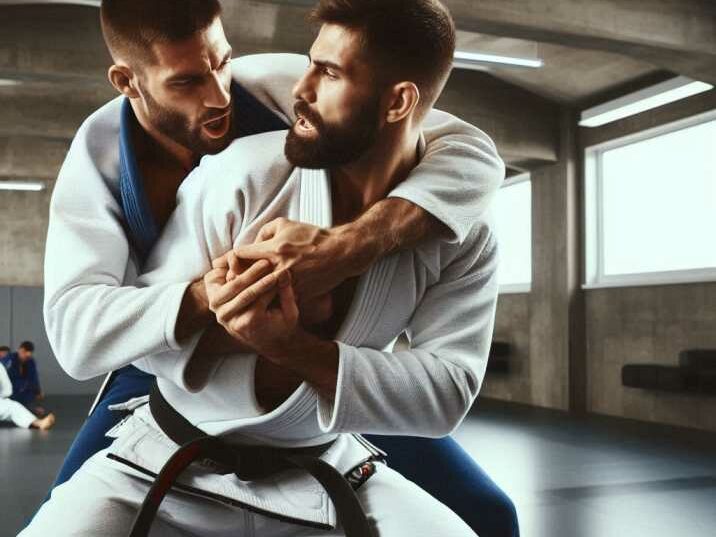Introduction
Table of Contents
Brazilian Jiu-Jitsu (BJJ) is revered worldwide for its effectiveness in grappling and self-defense. But many aspiring martial artists often wonder, “Is Brazilian Jiu-Jitsu hard to learn?” In this comprehensive blog post, we’ll demystify the learning process of BJJ, breaking down what makes it challenging, how you can overcome these challenges, and what you can expect on your journey. Whether you’re a complete beginner or someone with a bit of martial arts background, this guide will provide valuable insights to help you navigate the world of BJJ.

What to Expect
- An overview of Brazilian Jiu-Jitsu
- Factors that make BJJ challenging
- Tips for overcoming these challenges
- The benefits of learning BJJ
- Common FAQs
Understanding Brazilian Jiu-Jitsu
What is Brazilian Jiu-Jitsu?
Brazilian Jiu-Jitsu is a martial art focusing on ground fighting and submission grappling. Developed from Japanese Jiu-Jitsu and Judo, BJJ emphasizes technique, leverage, and body mechanics to control and submit opponents, regardless of their size.
History of BJJ
The art was popularized by the Gracie family in Brazil during the early 20th century. Helio Gracie, in particular, adapted traditional techniques to suit his smaller frame, making BJJ a highly practical form of self-defense.
Core Principles
Leverage
Leverage is about using your body mechanics to gain an advantage over your opponent. Instead of relying on brute strength, BJJ techniques utilize proper positioning and movement to maximize efficiency. By applying pressure at the right points and angles, even a smaller practitioner can effectively control a larger opponent.
Positioning
Positioning involves controlling the spatial relationship between you and your opponent. Good positioning allows you to maintain dominance in a fight, dictating the pace and flow of the match. This principle emphasizes staying in advantageous positions, like the mount or guard, while avoiding or escaping from disadvantaged ones.
Submission
Submission refers to the techniques used to force an opponent to surrender. This is achieved through joint locks and chokeholds that can incapacitate or cause significant pain. Submissions are the ultimate goal in BJJ, showcasing the effectiveness of technique and strategy over physical strength alone.
Is Brazilian Jiu-Jitsu Hard to Learn?
Factors That Make BJJ Challenging
1. Physical Demands
BJJ demands a high level of physical fitness, requiring flexibility, strength, and endurance. The intense grappling sessions and rolling (sparring) can be physically exhausting, pushing your body to its limits and improving overall fitness.
2. Mental Toughness
The mental aspect of BJJ is equally challenging. You must learn to stay calm under pressure, deal with constant resistance, and handle the frustration of being submitted repeatedly. Developing mental resilience is key to progressing in BJJ.
3. Complex Techniques
BJJ techniques are often intricate and require precise movements. Mastering these techniques takes time, consistent practice, and attention to detail. The learning curve can be steep, but persistence leads to improvement.
4. Sparring (Rolling)
Sparring, or rolling, involves live grappling with a resisting opponent. This can be intimidating and challenging for beginners, as it tests your skills in real-time situations. It’s a crucial part of training that helps develop practical application of techniques.
5. Injuries
Like any physical sport, BJJ carries a risk of injuries. Common injuries include joint strains, muscle soreness, and occasional bruises. Being mindful of your body, using proper technique, and training safely can help minimize these risks.
Overcoming the Challenges
1. Consistent Practice
Consistency is crucial in BJJ. Regular training sessions help improve your skills, enhance fitness levels, and build muscle memory, making techniques feel more natural and intuitive over time.
2. Embrace the Process
Understand that BJJ is a long-term journey. Progress may be gradual, but every small improvement counts. Embracing this process helps you stay motivated and appreciate your growth.
3. Focus on Fundamentals
Mastering basic techniques is essential for a strong foundation. Concentrate on core movements like hip escapes, guard passes, and basic submissions to build a solid base for more advanced techniques.
4. Stay Mentally Resilient
Developing mental toughness is key. Embrace the challenges you face during training, and learn from each experience, whether you succeed or fail. This resilience will aid your overall growth in BJJ.
5. Listen to Your Body
To prevent injuries, always listen to your body. Ensure thorough warm-ups, regular stretching, and avoid pushing through pain. This approach keeps you healthy and able to train consistently.
Benefits of Learning Brazilian Jiu-Jitsu
1. Self-Defense
BJJ is highly effective for self-defense, teaching techniques designed to neutralize threats. Its focus on leverage and technique allows practitioners to control or subdue larger opponents.
2. Physical Fitness
BJJ offers a comprehensive full-body workout, enhancing strength, flexibility, and cardiovascular health. The dynamic nature of training keeps you physically active and fit.
3. Mental Health
Training in BJJ can significantly reduce stress, boost confidence, and enhance mental resilience. The discipline and focus required in practice contribute to overall mental well-being.
4. Community
BJJ schools often foster a strong sense of community. Training partners frequently become friends, creating a supportive and encouraging environment that enhances the training experience.
5. Discipline and Focus
Regular BJJ training instills discipline, focus, and a strong work ethic. These attributes not only improve your martial arts skills but also positively impact other areas of your life.
Conclusion
So, is Brazilian Jiu-Jitsu hard to learn? The answer is both yes and no. While BJJ presents challenges, they are surmountable with consistent effort, mental resilience, and a willingness to embrace the journey. The benefits of learning BJJ go beyond physical fitness and self-defense, offering valuable life skills and a sense of community. Whether you’re a beginner or an experienced martial artist, BJJ has something to offer everyone.

FAQs About Learning Brazilian Jiu-Jitsu
1. How long does it take to get good at BJJ?
It typically takes several years to become proficient in BJJ. Progress depends on factors like training frequency, natural ability, and dedication.
2. Can I start BJJ if I’m not in shape?
Yes, you can start BJJ regardless of your fitness level. Training will naturally improve your fitness over time.
3. What should I wear to my first BJJ class?
Wear comfortable athletic clothing. If you have a gi (uniform), bring it. Many schools offer loaner gis for beginners.
4. How often should I train?
Training 2-3 times per week is a good starting point. As you progress, you may increase the frequency based on your goals.
5. Is BJJ safe for kids?
Yes, BJJ is safe for kids when taught by qualified instructors. It promotes physical fitness, discipline, and self-defense skills.


